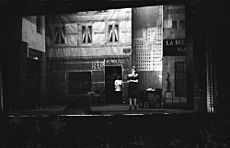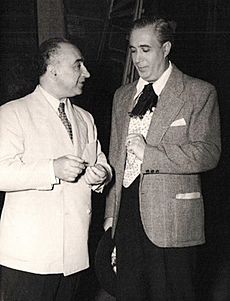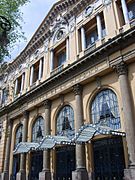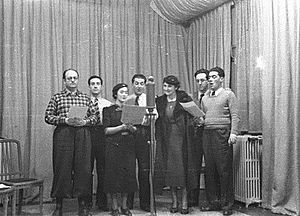Pepita Embil facts for kids
Quick facts for kids
Pepita Embil
|
|
|---|---|

Embil in the 1940s
|
|
| Born |
Josefa Embil Echániz
28 February 1918 |
| Died | 28 August 1994 (aged 76) Mexico City, Mexico
|
| Spouse(s) | Plácido Domingo Ferrer |
| Children | Plácido Domingo |
Josefa Embil Echániz (in Basque: Josefa Enbil Etxaniz; born February 28, 1918—died August 28, 1994), better known as Pepita Embil, was a Spanish singer. She was a Basque soprano, famous for her roles in zarzuela and operetta shows. A zarzuela is a Spanish musical play that mixes singing, dancing, and spoken parts. An operetta is a lighter, shorter opera.
Pepita Embil performed all over Spain and Latin America. People called her the "Queen of Zarzuela." She is also well-known as the mother of the world-famous opera singer Plácido Domingo. She helped him start his amazing career. Embil began singing professionally in choirs. One of these was the Basque national choir, Eresoinka, which was based in France during the Spanish Civil War. When she was still in her twenties, she starred in the very first performances of several new zarzuelas. She worked with important Spanish composers like Federico Moreno Torroba and Pablo Sorozábal. In 1948, she moved to Mexico with her husband, Plácido Domingo Ferrer, who was also a singer. In Mexico, they ran their own successful zarzuela company and toured across the Americas. Throughout her career, Embil made several recordings, mostly of zarzuela music.
Contents
Her Life and Career
Early Years and Musical Start
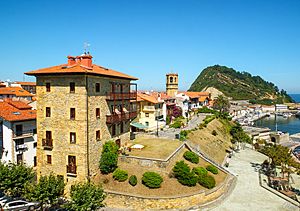
Josefa "Pepita" Embil was born on February 28, 1918. Her hometown was Getaria in the Basque Country of Spain. Her father, Arturo Embil y Lazcano, was a church organist. He loved zarzuelas and enjoyed playing opera music on the piano. Pepita was one of five children. Her father passed away when she was 11 years old.
With her father's encouragement, Pepita started singing lessons as a child. She later went to the conservatory in San Sebastián. There she studied with a bass singer named Gabriel Olaizola.
Embil began her singing career in a Basque choir called Euzko-Abesbatza. Her teacher, Olaizola, led this choir. She made her first big stage appearance at the Liceu theater in Barcelona on April 12, 1934. She was only sixteen years old. She sang a small part in a Basque opera called Amaya. After this, she performed the opera in other theaters, including the Teatro Arriaga in Bilbao. These performances were very successful. She also gave concerts, singing different types of music. She later joined the famous Orfeón Donostiarra choir. She said she needed to "work to live."
In 1937, during the Spanish Civil War, Embil joined a new group. It was the Basque national choir and ballet, Eresoinka. The goal was to keep Basque musical culture alive. Embil toured widely with this group outside of Spain. She often sang as a solo singer within the choir. Eresoinka performed in major cities like Paris, Brussels, and London. Although she was mostly a soprano, she sang alto parts with Eresoinka. After her last concert with the choir in Paris in 1939, she stayed there to study with a singing teacher.
Zarzuela Star in Spain
After the Spanish Civil War ended, Pepita Embil moved to Madrid. She looked for work in the many zarzuela companies there. She joined a touring company led by the composer Federico Moreno Torroba. She soon performed in his zarzuela Sor Navarra. In this show, she met baritone Plácido Domingo Ferrer for the first time. They married on April 1, 1940. Their first child, Plácido Domingo, was born early the next year. A year and a half later, they had a daughter, Maria José (1942-2015), known as "Mari Pepa."
From 1940 to 1945, Embil often worked with the Teatro Calderón company in Madrid. She and some friends from the Teatro Calderón started their own zarzuela company called Ases líricos. This company had many successes for decades. Many of its members were among the best zarzuela singers in Spain. Pepita and her husband performed all over Spain with this group. Embil quickly became a favorite singer for several leading Spanish composers. These included Moreno Torroba, Pablo Sorozábal, and Jacinto Guerrero.
After her son was born, she performed in many zarzuela productions. In 1941, she appeared in the first performance of Quiroga's La reina fea. In 1942, she performed in the premiere of Federico Cotó's operetta, El desfile del amor. In 1943, she sang in the very successful premiere of Pablo Sorozábal's zarzuela, Don Manolito. She also had a big hit in Sorozábal's Black el payaso. She performed in the first shows of other zarzuelas, like Guerrero's Loza lozana and Jesús Romo's En el balcón de Palacio. Romo's zarzuela was an instant hit, and Embil sang the main role. Her last world premiere in Spain was in 1944. She starred in Guerrero's Tiene razón Don Sebastián. By this time, the zarzuela style was becoming less popular. Pepita Embil starred in some of the last great zarzuelas ever written.
Moving to Mexico
After touring Spain, Pepita Embil and her husband went on a tour of Latin America. They joined a new zarzuela company formed by Federico Moreno Torroba. When she first arrived in Mexico, a newspaper described her as a "tall, young, and good looking" Basque singer with a powerful voice. While on tour, Moreno Torroba wrote a Mexican zarzuela called El orgullo de Jalisco. It included Mexican music and traditions. In September 1947, Embil starred in the main role of this new zarzuela in Mexico City. The audience loved it. The company's shows were very popular in Puerto Rico, Cuba, Venezuela, and especially Mexico.
Because of this success, Pepita and her husband decided to start their own company. They settled permanently in Mexico in late 1948. Embil's sister, Agustina, took care of their children in Spain while they were touring. In January 1949, Agustina brought the children to Mexico. Soon, the children also appeared in small parts in their parents' zarzuela shows. Embil and Domingo often performed in Mexico City. They also toured many other countries in Latin America. They produced and starred in famous zarzuelas like Luisa Fernanda and La tabernera del puerto. Even though Embil mostly sang zarzuela, she also performed in operettas. These included Spanish versions of The Dollar Princess and The Merry Widow.
A Mexican critic wrote in 1949 that Embil and her co-star "provoked delirious and very loving ovations." For over twenty years, Pepita Embil and her husband were popular singers and business owners in Mexico. Embil also gave concerts. Sometimes, her son, Plácido, played the piano for her. In the mid-1950s, she often performed in zarzuelas with her son. He was just starting his own singing career. She and her husband had given him his first singing lessons at home.
Later Life and Farewell
After many years away, Pepita Embil and her husband accepted invitations to perform in Spain again. In 1966, they toured the Canary Islands and northern Spain. When they returned to Mexico, they went on another tour to Costa Rica, Peru, and Venezuela. Later, they sang at the Teatro de la Zarzuela in Madrid. This brought back memories of their early successes there in the 1940s.
They returned to Barcelona in 1974. Their son, Plácido Domingo, conducted them in the zarzuela Doña Francisquita at the Liceu. She sang the mezzo-soprano role of Aurora la Beltrana. This was her final zarzuela performance and her farewell to the stage.
In 1985, during the 1985 Mexico City earthquake, some of her family members died. Her husband, Plácido Domingo Ferrer, passed away in 1987. In 1988, the Teatro de la Zarzuela honored her. They dedicated a performance of La chulapona to her. In 1990, Embil and her son sang a duet together in San Sebastián. Pepita Embil died on August 28, 1994, in Mexico City due to a health issue. She was 76 years old. She is buried next to her husband.
Her Legacy
Pepita Embil is still remembered as one of the most important zarzuela stars in the Americas. In 2012, a Spanish reporter said she was "considered one of the most expressive voices of zarzuela." Her son, Plácido Domingo, believed she would have been a very successful opera singer. He wrote that she once turned down an offer to sing opera roles because she was already a big zarzuela star. After she passed away, a music critic praised her "warm and sweet" voice.
In 1993, her son created the Pepita Embil Domingo Prize of Zarzuela to honor her. This prize is part of his worldwide Operalia singing competition. Each year, a female singer receives $10,000 for her excellent performance in the zarzuela part of the competition. In 2002, a plaza in Puebla, Mexico was named Plaza Pepita Embil de Domingo after her. Ten years later, a Basque filmmaker made a Spanish documentary about Embil called La reina de la zarzuela (The Queen of the Zarzuela). It was shown on television in 2014. In the documentary, Plácido Domingo visited his mother's hometown of Getaria. He shared memories of her and visited her birthplace. Her granddaughter, Mexican actress Maite Fernández Domingo, performs under the name Maite Embil to honor her.
Recordings and Television
Embil started recording music as a Basque choir singer in the late 1930s. For the next few decades, she continued to record parts of zarzuelas, operettas, and musicals. She also recorded popular Latin songs. On one of her albums, she even recorded an opera song called "Un bel dì vedremo" from Puccini's Madama Butterfly. In the 1960s and 1970s, she filmed some popular zarzuelas with her husband for Mexican television.
Some of Her Recordings
78 rpm records
| Year | Album | Singers | Conductor, Ensemble |
Label | Notes |
|---|---|---|---|---|---|
| circa 1938 |
Aurtxoa seaskan | Pepita Embil | Gabriel Olaizola, Chorale Basque Eresoinka |
Disque Gramophone Cat: K-8293 |
|
| 1942 | Black, el payaso (Sorozábal) | Antonio Medio, Pepita Embil, Marcelino del Llano, Enriqueta Serrano, Manuel Alares, Manuel Gas |
Pablo Sorozábal, Orquesta del Teatro Reina Victoria |
Discos Columbia Cat: R-14088 — R-14094; CA-15058 — CA-15064 (7 records) |
|
| 1943 | La tabernera del puerto (Sorozábal) | Pepita Embil, Enriqueta Serrano, Antonio Medio, Marcelino del Llano, Manuel Gas, Manuel Alares |
Pablo Sorozábal, Orquesta del Teatro Reina Victoria |
Discos Columbia Cat: R-14095, R-14096, R-14103 (3 records) |
|
Long-playing records (LPs)
| Year | Album | Singers | Conductor, Ensemble |
Label | Notes |
|---|---|---|---|---|---|
| 1958 | Pepita Embil: Trozos inmortales de zarzuelas | Pepita Embil, Plácido Domingo Embil |
Luis Mendoza López | RCA-Victor Cat: MKL-1144 |
|
| 1960 | Canciones inolvidables | Pepita Embil | Gonzálo Cervera | RCA-Camden |
|
| 1965 | Fragmentos de operetas inmortales | Pepita Embil | Luis Mendoza López, Orquesta de Camara |
RCA-Victor |
|
See also
 In Spanish: Pepita Embil para niños
In Spanish: Pepita Embil para niños



